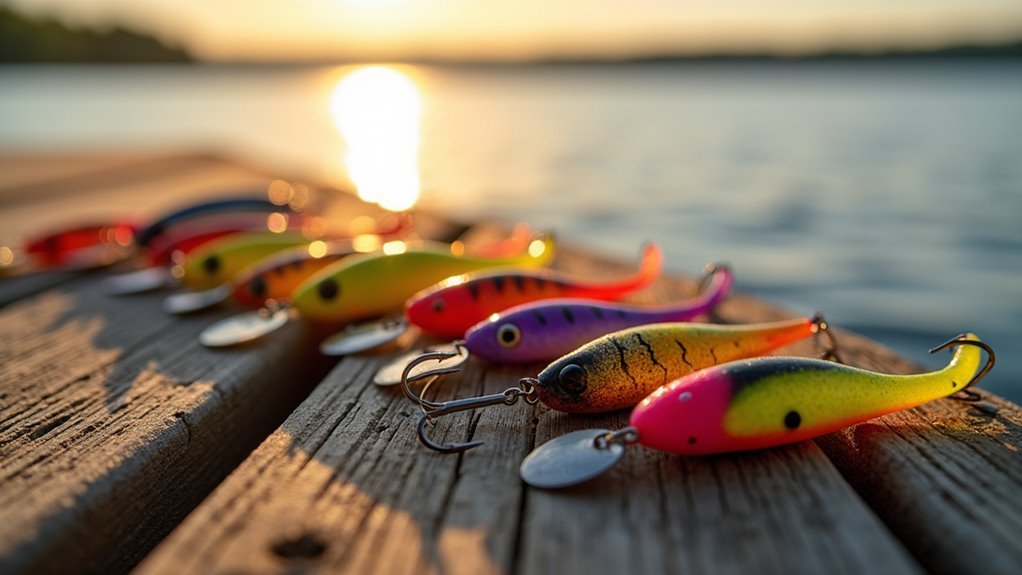Successful bluegill and sunfish fishing relies on understanding these aggressive panfish’s seasonal patterns. Anglers should use light tackle (5-6 foot rods with 4-8 pound test line) and small hooks (No. 6-10) to match their tiny mouths. Live bait like nightcrawler pieces, red worms, and crickets work consistently, while tube jigs and micro spinners shine as artificial options. Target slack waters near structure, adjusting locations as fish move from shallow spawning areas to deeper summer haunts for year-round success.
Understanding Bluegill and Sunfish Behavior

While bluegill and sunfish might seem simple to catch, understanding their behavior is key to consistently landing bigger specimens.
These members of the sunfish family are naturally aggressive feeders, which explains why they’ll bite at almost anything that resembles food. Their habitat preferences are quite specific – they generally avoid strong currents, preferring slack waters near deep holes, banks, and weed beds.
During spawning season, when water hits about 70 degrees, they’re particularly visible in shallow flats. I think this knowledge becomes vital for seasonal fishing success.
Perhaps what makes bluegill fishing so versatile is how they adapt through seasons, offering year-round opportunities with spring and summer being prime times.
Essential Gear for Light Tackle Success
Selecting the right gear can make all the difference when pursuing bluegill and sunfish. Light tackle enhances the experience, with 5-6 foot light or ultralight rods being ideal. These smaller setups make even modest catches feel substantial.
Spinning reels paired with 4-8 pound test line work perfectly for most situations, though ultralight setups might need 2-pound test.
I think hook size is critical – small bait hooks between No. 6 and No. 10 accommodate bluegill’s notoriously small mouths.
Live Bait Strategies That Consistently Produce
Most successful bluegill anglers rely on live bait as their go-to strategy, and for good reason.
Live bait mimics the natural food sources that sunfish aggressively feed on year-round, making it perhaps the most reliable approach for consistent catches.
Nothing beats live bait for bluegill success—it matches what these aggressive feeders naturally hunt throughout all seasons.
- Nightcrawlers – Break these larger worms into smaller pieces that fit a bluegill’s mouth perfectly.
- Red worms – Use these whole, as they’re already sized right for sunfish.
- Crickets – Hook through the thorax in summer months to keep them alive and kicking.
- Larvae – Waxworms and mealworms work especially well during cooler seasons.
Bottom fishing with split-shot rigs tends to outperform other methods when fish are deeper.
Mastering Lure Selection and Presentation

Though live bait often steals the spotlight, artificial lures can be just as deadly for bluegill and sunfish when you know what to choose and how to present them. Jigs reign supreme in the bluegill angler’s arsenal, particularly soft plastic tubes that allow quick color changes when fish get finicky.
| Lure Type | Best Season | Retrieve Style |
|---|---|---|
| Tube Jigs | Spring/Summer | Slow, twitching |
| Micro Spinners | Summer | Steady, medium |
| Tiny Crankbaits | Fall | Stop and go |
| Micro Flies | All Seasons | Subtle, pulsing |
The key to success is matching your presentation to the fish’s mood. Sometimes a dead-slow drag across the bottom works, while other days, they want a bit more action.
Seasonal Patterns and Prime Fishing Locations
Understanding when and where to find bluegill and sunfish can transform your lure presentation from random casting to targeted success.
These fish follow predictable seasonal patterns that, once recognized, make fishing more rewarding and less random.
When water temperatures hit around 70 degrees, you’ll find these panfish in their spawning mode.
I think this creates one of the year’s best opportunities for consistent action.
- Pre-spawn – Look for bluegill moving toward shallow, food-rich flats
- Spawning – Target oval-shaped nests in shallow areas
- Summer – Focus on weed edges and deeper structure
- Year-round – Seek slack water areas over strong currents
Species Identification and Targeting Techniques
The 34 different species in the sunfish family can initially confuse anglers who might be catching several varieties without even realizing it.
Bluegill remains the most popular target, recognizable by its deep body and distinctive black gill flap, while pumpkinseed sunfish often show more vibrant coloration with orange-spotted patterns.
Bluegill’s distinctive black gill flap sets it apart from the more colorful pumpkinseed with its eye-catching orange spots.
For targeting bluegill specifically, focus on quieter waters near vegetation using small hooks and pieces of nightcrawlers.
The redear sunfish (or shellcracker) prefers slightly deeper water and responds well to bottom fishing techniques.
I think identifying which species you’re after helps tremendously in selecting the right approach and location for consistent success.
Frequently Asked Questions
Can Bluegill and Sunfish Be Safely Consumed From All Water Bodies?
Bluegill and sunfish aren’t safe to consume from all water bodies. They shouldn’t be eaten from polluted waters, as they can absorb contaminants that pose health risks to humans.
How Do Tournament Anglers Approach Bluegill Fishing Differently Than Casual Anglers?
Like wolves stalking prey, tournament anglers use specialized lures and target larger bluegill, meticulously studying seasonal patterns and habitat, while casual anglers often rely on simple live bait techniques.
What Are Effective Methods for Cleaning and Filleting Sunfish?
Effective sunfish cleaning methods include scaling with a scaler, gutting with a sharp knife, and filleting by cutting along the backbone. Many anglers prefer boneless fillets for their small size.
Do Bluegill and Sunfish Populations Require Conservation Management in Certain Regions?
Bluegill and sunfish populations do require conservation management in many regions. They’re susceptible to overfishing, habitat degradation, and climate change impacts, necessitating catch limits and habitat protection measures.
Can Bluegill Be Successfully Farm-Raised for Food or Stocking Purposes?
Yes, bluegill can be successfully farm-raised. They’re commonly cultured in aquaculture operations for both food production and stocking programs that support recreational fishing opportunities across various regions.